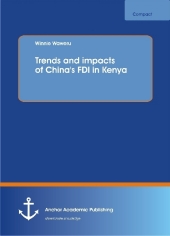 Neuerscheinungen 2016Stand: 2020-02-01 |
Schnellsuche
ISBN/Stichwort/Autor
|
Herderstraße 10
10625 Berlin
Tel.: 030 315 714 16
Fax 030 315 714 14
info@buchspektrum.de |

Winnie Waweru
Trends and impacts of China´s FDI in Kenya
2016. 40 S. 9 Abb. 220 mm
Verlag/Jahr: ANCHOR ACADEMIC PUBLISHING 2016
ISBN: 3-9606709-2-3 (3960670923)
Neue ISBN: 978-3-9606709-2-6 (9783960670926)
Preis und Lieferzeit: Bitte klicken
Since China´s reforms, the country has experienced tremendous growth and expansion. China´s government has encouraged the companies to go global, with the recent reforms of the "Go West" and "Going Global" policy. Since China became a member of the World Trade Organisation in 2001, economic reforms have led to a spectacular economic success which has generated rapid economic growth over two decades. The country has moved from a centrally-planned economy towards a market economy.
This research study focuses on the impact and the trends of Chinese FDI (foreign direct investment) on Kenya´s economic sectors of agriculture, infrastructure, manufacturing, and tourism. It seeks to quantify the advantages and disadvantages through the SWOT analysis and to suggest policies necessary to maximize the development impact of China in Kenya. The study takes a qualitative and quantitative approach with close textual analysis of the existing data and information from the Kenya embassy in Beijing and KIA and auxiliary information from existing written literature, books, internet sources, journal articles and interpretation of these sources.
Text Sample:
Chapter 3. Methodology:
This research study took a qualitative and quantitative approach, with close textual analysis of the existing data, as well as discussions which were conceived as qualitative expert interview (from the Kenya embassy in Beijing and KIA officials). Auxiliary information was obtained from existing written literature, books, scientific papers, journals and interpretation of the existing information and data.
The applied methodology approach sought to answer the three research questions stated below:
I. What are trends of CFDI in different sectors (agriculture, tourism, manufacturing, and infrastructure development)?
II. Are there positive or negative impacts of CFDI in Kenya?
Using the simple regression Model: GDP (Y) = + beta0X0 + beta1X1 + beta2X2+beta3X3.
III. What are the opportunities and threats of CFDI in the Kenyan economy?
This study posed some difficulties due to the biasness of the data and lack of real-time information. The existing data was not comprehensive, thus, the researcher was faced with difficulties in the interpretation of the results.
4. Results and Discussions:
The data for this study was acquired from the Kenya Investment Authority (KIA), Kenya Beijing embassy 2014 data and interviews (Appendix D) with various experts providing a deeper understanding of the CFDI in Kenya. The types of CFDI are diverse they include; restaurants set-ups, car/motorbike or bicycle assembling, coffee or tea growing, toys manufacturing, cement manufacturing, road/ airports construction and real estate development among much more.
According to Kenya Investment Authority report 2014, most of the Chinese companies in Kenya are either fully owned by Chinese companies or are privately owned, hence very limited or no local capital. The capital cost is mainly foreign which is so much needed in the country. The foreign capital in 2014, averaged to 62231.28 (KSH in millions) and local capital of 726.05 (KSH in millions). With the capital extensive sectors like manufacturing and construction attracting the highest amount of foreign capital. In 2014 agriculture attracted the least amount of foreign capital and zero local capital. The construction and the manufacturing sectors attract the highest number of foreign employment which is primarily managerial positions hence the evidence of managerial skills transfer to the local Kenyan people. This is contrary to the popular "stories" that CFDI only hire the Chinese people in the host countries. In 2014 there was 11264 local employees and only 1077 foreign employees. ISIC indicates that the investments in 2014 were scattered in the sectors of manufacturing, service, tourism and construction, with service and manufacturing sectors offering the highest number of employment to the local people, hence improving people´s livelihood.


